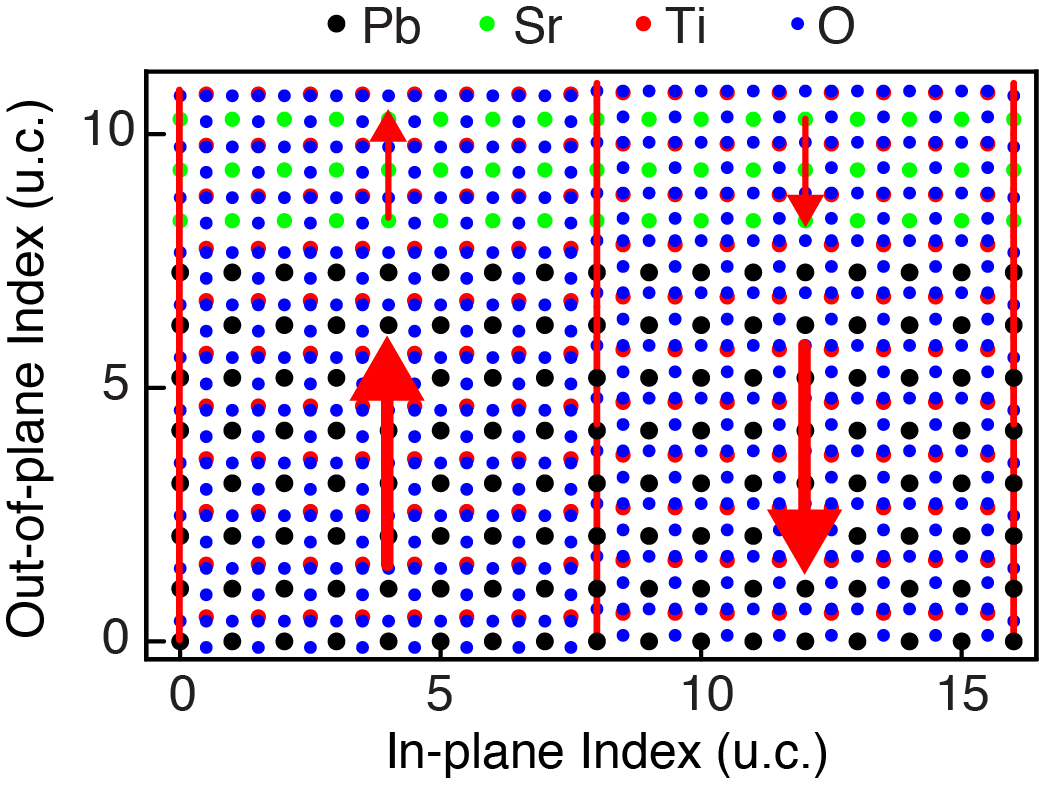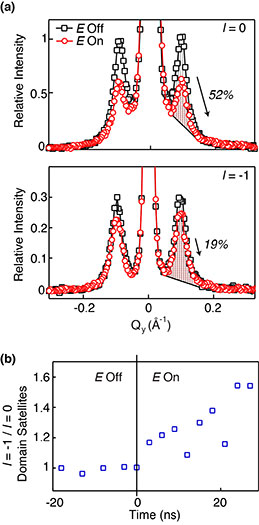A ferroelectric-dielectric superlattice (SL) is a precisely formed stack of atoms created by depositing alternating ultrathin layers of a ferroelectric material such as lead titanate (PbTiO3) and a dielectric material such as strontium titanate (SrTiO3). In weakly coupled PbTiO3/SrTiO3 (PTO/STO) superlattices, the electrical polarization arising from the crystal structure is distributed unequally between the component layers. The unequal distribution leads to formation of a complex domain pattern consisting of a series of nanoscale stripes of differing polarization. An applied electric field distorts the domain structure and ultimately transforms the SL to a uniformly polarized state containing no domains. The changes in the polarization-domain configuration and atomic structure within each component layer during the application of the electric field are not yet understood, partly because the transformation to a uniform polarization state takes place over a nanosecond time scale.
Insight into the origin of the time-domain properties of SLs has the potential to extend the functionalities of complex oxides by providing the means to tune the field and time dependences of their electronic properties, perhaps paving the way for their use in new, multifunctional microelectronic devices.
Researchers conducted in situ time-resolved x-ray microdiffraction experiments at the U.S. Department of Energy Office of Science's Advanced Photon Source in which the changes occurring in the domain pattern and atomic structure of PTO/STO SLs were probed with a resolution of 100 ps. Among the key results of this study, the researchers found that the ferroelectric and dielectric components responded differently to the applied field in reaching the uniformly polarized state.
The researchers from the University of Wisconsin-Madison, Stony Brook University, and Argonne National Laboratory considered the structural changes following application of the electric field as occurring in two time regimes. In the first regime, which persists for durations of 1 ns to 100 ns after the onset of the electric field, the striped domain geometry remains but becomes metastable. In the second intermediate regime, the SLs transform to a uniformly polarized state in some areas while remaining as metastable striped domains in other areas (see the first figure).
In the first time regime, the intensity of the domain-related x-ray scattering decreased gradually as the overall domain population declined. The experimenters found, however, that the rate of this decrease depended on the Miller indices (a notation system in crystallography for planes in crystal lattices) of the planes associated with the satellite reflections, indicating that additional structural changes accompanied the transformation (second figure).
The researchers gained insight into the structural changes occurring in the domains by carrying out time-resolved x-ray microdiffraction experiments at X-ray Science Division beamline 7-ID-B,C,D of the Argonne Advanced Photon Source and analyzing the electric field-induced changes in x-ray intensities in terms of a kinematic x-ray diffraction simulation. Such an analysis showed that the initial distortion of the domains is consistent with the development of polarization in the STO layers.
During the initial 20 ns after application of the electric field, the domain structure responded with a distortion that increased the polarization in the STO layers but not in the PTO layers. Two mechanisms that could lead to the increased polarization in the STO layers were considered: (1) the walls between the nanodomains within the STO layers shifted due to the applied electric field, or (2) the relative positions of the atoms within the STO layers changed in the field. In both cases, the electric field would change the average polarization of the STO and produce intensity changes of the domain satellites that were consistent with the x-ray measurement.
At later times, the domain pattern disappeared and only structural SL x-ray reflections remained. The annihilation of the domain walls removed a mechanical constraint that suppressed piezoelectric distortion within the striped domains. With the constraint lifted, the SLs exhibited an out-of-plane lattice expansion.
In addition, the intensity of the SL structural reflections changed in a way that depended on the distribution of piezoelectric distortions within the repeating units of the SLs. By comparing the empirical results to predictions from a range of structural models, the researchers found that the intensity variation in the SL structural reflections showed that the STO layers expanded more than the PTO layers in applied electric fields. The larger piezoelectric distortion in the STO layers matched the expectation that the electric field increases the initially small polarization of STO and produces a correspondingly larger piezoelectric expansion.
Taken together, these two results show that the relatively weak polarization of the STO layers in a PTO/STO superlattice has important effects on the evolution of the domain pattern and atomic structure in applied electric fields.
The layer-dependent evolution of the nanometer-scale polarization configuration and the associated structural distortion were both consistent with theoretical predictions that applied fields lead to large increases in the polarization of the STO component.
— Vic Comello
See: Pice Chen1, Margaret P. Cosgriff1, Qingteng Zhang1, Sara J. Callori2, Bernhard W. Adams3, Eric M. Dufresne3, Matthew Dawber2, and Paul G. Evans1*, “Field-Dependent Domain Distortion and Interlayer Polarization Distribution in PbTiO3/SrTiO3 Superlattices,” Phys. Rev. Lett. 110, 047601 (2013).
Author affiliations: 1University of Wisconsin-Madison, 2Stony Brook University, 3Argonne National Laboratory
Correspondence: *[email protected]
This research was supported by the U.S. Department of Energy Office of Science Basic Energy Sciences, Division of Materials Sciences and Engineering under Grant No. DE-FG02- 10ER46147 (PE). M.D. acknowledges support from the National Science Foundation through Grant No. DMR-1055413. Use of the Advanced Photon Source at Argonne National Laboratory was supported by the U.S. Department of Energy Office of Science under Contract No. DE-AC02-06CH11357.
The Advanced Photon Source at Argonne National Laboratory is one of five national synchrotron radiation light sources supported by the U.S. Department of Energy’s Office of Science to carry out applied and basic research to understand, predict, and ultimately control matter and energy at the electronic, atomic, and molecular levels, provide the foundations for new energy technologies, and support DOE missions in energy, environment, and national security. To learn more about the Office of Science x-ray user facilities, visit http://science.energy.gov/user-facilities/basic-energy-sciences/.
Argonne National Laboratory seeks solutions to pressing national problems in science and technology. The nation's first national laboratory, Argonne conducts leading-edge basic and applied scientific research in virtually every scientific discipline. Argonne researchers work closely with researchers from hundreds of companies, universities, and federal, state and municipal agencies to help them solve their specific problems, advance America's scientific leadership and prepare the nation for a better future. With employees from more than 60 nations, Argonne is managed by UChicago Argonne, LLC for the U.S. Department of Energy's Office of Science.


